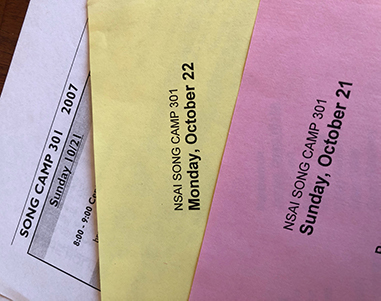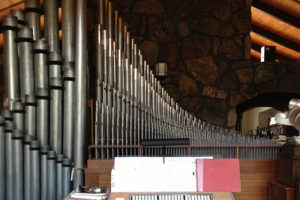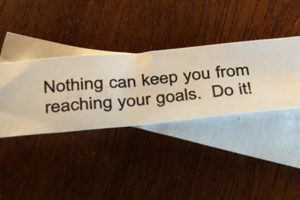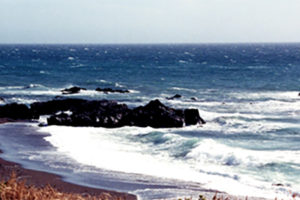NSAI Song Camp 301 was held October 21-23, 2007. This song camp was the last in the series and I was very excited about going. I also ordered tickets to the Bluebird Café for the late show on Tuesday night. Adrienne Pierce was the opening act and Jane Siberry was the main performer. I had not heard of either one. From their bios, it looked like their music is alternative/pop music. I was trying to soak up as many songwriting experiences as possible!
You wind up creating from silence, like painting a picture on a blank canvas that could bring tears to somebody’s eyes. As songwriters, our blank canvas is silence. Then we write a song from an idea that can change somebody’s life. Songwriting is the closest thing to magic that we could ever experience. That’s why I love songwriting.
— Rodney Atkins (b. 1969) American country music singer and songwriter
The faculty for NSAI Song Camp 301
The faculty for NSAI Song Camp 301 was Rick Beresford, Don Henry, James Dean Hicks, Angela Kaset, Ralph Murphy, and Hugh Prestwood.
Rick Beresford’s Class
Rick Beresford opened every morning discussing specific aspects of songwriting. Each day he gave us exercises to “wake up our muse.” For this song camp, the topic for our writing exercises was to be our first car.
O day one we wrote down the description, details, and any specific incidents about the car. He gave us five minutes to write whatever came to mind. After that, we began writing a song from the words or phrases we used in the exercise.
Over the next two days we followed the same procedure. On the second day we described how we felt about the car or how the car made us feel. On the third day our instructions were to make the car personify or symbolize something.
Ideally, we would have written three songs over the three days. And, using the same topic, we had three ways we could approach a song. The second day was better for me—describing emotions. In fact, on the other days, emotions crept in and I found it hard to keep them out.
On that second day of writing about the car, my thoughts turned to my father. He had picked out the car and bought it for me. Never before had I thought about my car in the way I did during that writing exercise. Our instructions were to write whatever came to mind: let our thoughts go wherever they wanted to go—just keep writing and do not edit.
Here’s what I wrote in those five minutes:
First Car
Silver, sexy car. Car of my dreams. Beyond my dreams. Embodiment of who I am and who I want to be. Different from everyone else. Feelings of exhilaration and sophistication. Driving that car, I was alive. I was free. I was an adult (almost, anyway). Able to go where I wanted to go. To work, to play, to drive by where he works. Enveloped in the dark vinyl, bucket seats like a cocoon. I was in there waiting to become a butterfly. Dark, sultry. Music on the radio and foot on the accelerator. I was in control of a machine, of my life. The silver cougar was a reflection of me, of my personality—cool, sophisticated, unattainable, sleek, introverted. It made a statement about values, about morals, about reality, about art and life.
Car beyond my dreams. Car of impulse. My father’s impulse for me. To provide for me—his little girl. Was it his view of me? Did he see me as all those things? Is that what he was? Of course it was. He was all those things. He knew style. He knew sophistication. He knew sex and luxury and quality. He loved the invention, the movement, the freedom. He wanted to be free and provide for me. I wanted to be free. But I did not know how. The silver cougar—fierce, elegant, sleek, sultry, stalker, hunting, fast, lean, muscular, calculating, sometimes gentle and mild. That earthy guttural cry of the motor. Running down the highway with power and exhilaration. Running down the highway toward somewhere, anywhere, and yet nowhere . . . the sky.
My Sketch for a Song
The borning cry
Cry of freedom
Daddy bought a car
for his little girlSymbol of love
Love of life
Daddy bought a car
for his little girlRite of passage
Into adulthood
Daddy bought a car
for his little girlBeing alive
Sleek, sophisticated, sexy
Daddy bought a car
for his little girlGoing toward somewhere,
anywhere, and yet nowhere
Daddy bought a car
for his little girl
So, there are no rhymes. It’s a sketch I did in a few minutes. At least it is different from my other songs.
The back story is that my father had gone to the dealership because a salesman had called him saying that they had a great car for my mother. She could trade in hers for a newer model. When my father got there, the salesman said the car he mentioned had been sold. Daddy was angry and the salesman showed him a different car to try to appease him.
The car was a 1973 silver Mercury Cougar. It was a demo but did not have many miles. It was beautiful. Not too many people I knew drove Mercury Cougars. I had seen a red one advertised on Saturday afternoons on the Pro Bowlers Tour on the ABC TV show. I really liked it and never dreamed I would get that make of car. I’m not sure we had ever discussed my car yet. He bought the car in January and I did not turn sixteen until March.
Thought’s from NSAI Song Camp 301
. . . from Rick Beresford’s class:
The number one purpose of songwriting is to entertain. You must entertain the listener. We do that by reaching their emotions.
Read lyrics every day and underline important words. Notice interesting and good lines.
Learn to discriminate between ordinary and extraordinary.
Don’t underestimate the power of simplicity.
Compelling emotion is important to any song.
Originality is a series of tiny surprises.
. . . from James Dean Hicks’ class:
Feel what the day is bringing you. (whether it be ballads, stories, a quirky song, etc.)
What we listen to makes us who we are.
Sing the melody that comes out of you. Trust who you are.
There are no absolutes in songwriting. And, there are no rules in songwriting. There are things that work and things that don’t. It depends on the song.
. . . from Don Henry’s class:
A distinct style and identity are good. They get your foot in the door.
. . . from Angela Kaset’s class:
You must put into you what you need. Feed yourself and your muse.
Make sense of life by writing about it in a song.
. . . from Ralph Murphy’s class:
Melody gets the listener in, the lyric keeps them in.
Make songs singable. The listener wants to sing along.
You will be the sum of the people you know.
We have the gift of perception and we can look at people and know them. We must give them. . . themselves.
. . . from Hugh Prestwood’s class:
The key line should be the last line. (Never in the middle of the verse.)
The best couplet should be at the end of verse.
Sometimes just the right adjective makes an OK line into a great line.
(e.g., “victim of sweet circumstance”)
Don’t ever panic when you are working . . . then, a cloud comes over you. Stop your work and start again the next day.
Tuesday Night Concert at the Bluebird
I got to the Bluebird early and was able to sit at the table right in front of the stage. The crowd was different from the usual folks I had seen there. They were younger and definitely not country. As I heard them talking beforehand, it was obvious they were devoted fans of Jane Siberry.
I had never heard of her, but her bio was interesting. She was not a typical singer-songwriter and she was not country. Her music had been used on TV and in movies. I was excited because I really had not been able to relate the style of any of my songs to the people I had met in Nashville. I enjoyed studying with all the Nashville writers; however, they were lyrically and musically in a different place than I could probably ever be.
A Little About Jane Siberry
Jane Siberry is a Canadian singer-songwriter. Her first hit, “Mimi on the Beach,” is a seven-and-a-half-minute art-rock track from her album No Borders Here. She draws from a wide variety of musical styles from new wave rock, to a pop style influenced by jazz, folk, gospel, classical and liturgical music.
One of her best-known songs is “Calling All Angels” which is a duet with k. d. lang. Two of her songs, “The Valley” and “Love is Everything” are included on k.d. lang’s album Hymns of the 49th Parallel.
For Me, Something New
That Tuesday night show was like nothing I had ever experienced. Tim Ray, a jazz pianist and piano professor at Berklee College of Music, accompanied her on the keyboard in a jazz style. He held the performance together with his accompaniments which embodied the mood of the songs. A lot of it was written out . . . very unlike what I had seen there before.
This was the period when Jane was known as Issa. Her mesmerizing stage presence carried her performance. She took me along on journeys with the stories in her songs. I really did not care where she went. She managed to entice me into her world as she performed. When it was over, I honestly did not know what I had witnessed. It was more akin to performance art or maybe opera—more than just a group of songs strung together.
Later, after returning home, I discovered that she offered her music online for whatever price you wanted to pay—and free if you could not pay. I downloaded all the albums that I could not find copies of to purchase. I had found a songwriter different from those I had met in Nashville or Virginia and wanted to study her music.
Final Thoughts about NSAI Song Camp 301

During his class, Don Henry suggested that I get Joni Mitchell’s book Joni Mitchell: The Complete Poems and Lyrics. I ordered it as soon as I got home. It arrived Monday, October 29 and I was eager to start reading. Even though I knew many of her songs, listening to a song is not the same as reading the words on the page. Having the poems and lyrics in a book allows you to study and ruminate over the rhymes and images.
A comment I often got from people in my classes was that my songs sounded Irish or Celtic. After song camp, I ordered a CD by Loreena McKennitt along with other Celtic CDs so I could explore that music.
When I opened Loreena’s CD the book of secrets, the first words I saw on the back of the booklet were:
A good traveller has no fixed plans and is not intent on arriving.
— Lao Tzu (unknown, 6th – 4th century BC) ancient Chinese philosopher and writer
So, my journey during the year of 2007 was very focused. But, maybe, I needed to loosen up and not be so intent on the destination—of deciding what kind of songwriter I would be. I had hoped this song camp would give me some clues about where I was headed with my songwriting. I knew that I was not writing songs for country radio. But, then again, I wasn’t sure my songs sounded like singer-songwriter songs. All I knew is I should continue writing the songs that I felt inspired to write.










Leave a Reply
Your email is safe with us.